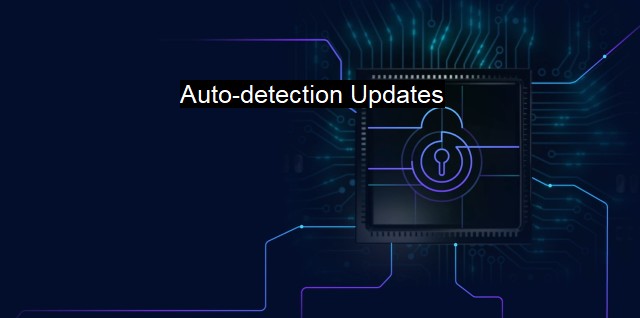What are Auto-detection Updates?
The Crucial Role of Auto-Detection Updates in Modern-Day Cybersecurity: Real-Time Vaccination Against Threats
You come across multiple phrases and notions that play an integral role in specific operations or functions. One such crucial term in this field is "auto-detection updates". Understanding what this means is vital for anyone interested in or working in cybersecurity and antivirus protection fields.Auto-detection updates refer to a software feature that automatically identifies and implements necessary changes to enhance the software's functionality, security, and performance. These automatic updates cover changes such as patches, new security features, bug fixes, and vulnerability repairs for the software or system involved.
The purpose of an auto-detection update system within a software application or a security solution is to continuously monitor for new potential threats, risks, vulnerabilities and then apply relevant fixes or patches as updates to counter and protect against these risks. Hence, it is a feature that is configured for immediacy, timeliness, and maintaining the software's robustness in its defense against cybersecurity threats.
With cyber threats continually growing and evolving, it's essential to have a system in place that automatically detects and updates cybersecurity solutions. It's virtually impossible for individuals and even small IT teams to keep abreast of all these developments and upgrades manually. For instance, imagine an antivirus software installed on a system. This software must consistently evolve and improve to counter cyber threats effectively, which the threat actors are advancing and developing continuously. Therefore, manual detection and update implementation may not only prove time-consuming but also insufficient in providing real-time protection.
Relating auto-detection updates to antivirus software, these updates are akin to vaccines upon the discovery of a new virus or mutation. When the antivirus software provider identifies a new security threat or vulnerability, it quickly creates a solution or update and rolls it out. The auto-detection update would then automatically download this solution and implement it to strengthen the system's security without needing user intervention.
It's worth noting that, in some cases, users may need to approve an update before it's applied. Yet, this usually depends on the software’s configuration and user settings. this is common in operating systems, where updates can sometimes cause changes that disrupt workflow or user preference.
The frequencies of these updates may also vary. Some software might check for updates regularly, like hourly or daily, while other programs might perform this check less frequently. The critical factor here is for the system to update before a cybercriminal exploits a vulnerability.
The introduction of auto-detection updates has brought a higher level of proactive behavior into the world of cybersecurity. Instead of waiting for a breach to happen and then responding, this feature ensures security measures keep evolving concurrently as new threats emerge.
Given the time-sensitive nature of cybersecurity, auto-detection updates can offer numerous benefits. It can effectively mitigate and prevent security breaches, protect sensitive information, minimize downtime due to potential threats, and uphold a company's reputation by ensuring high security.
Relying solely on auto-detection updates isn't entirely risk-free. It may miss out on detecting some threats, and there can also be instances of false positives. A false positive means the antivirus software flags a safe file as a threat, and this can disrupt a user’s workflow.
Auto-detection updates symbolize an essential step forward in the cybersecurity space. Effective security now implies a round-the-clock and proactive approach to foresee, detect, monitor, resolve, and protect against the rapidly evolving challenges in the digital landscape. Every solution needs to continually update, evolve, and adapt; otherwise, it risks becoming obsolete. Auto-detection updates lie at the core of this proactive approach in the world of cybersecurity and antivirus software.

Auto-detection Updates FAQs
What are auto-detection updates in the context of cybersecurity and antivirus?
Auto-detection updates are regular updates done by antivirus programs to keep up with new types of malware and cybersecurity threats. The updates help enhance the program's ability to detect and remove malicious software, making sure that your system stays protected.How often do cybersecurity and antivirus programs release auto-detection updates?
Cybersecurity and antivirus programs typically release auto-detection updates frequently, sometimes on a daily basis. This is because cybercriminals are always finding new ways to circumvent security measures, and to keep your system secure, your antivirus program must keep up with the latest threats.Do I need to restart my computer after an auto-detection update?
Although it depends on the specific antivirus program you're using, most programs do not require a restart after an auto-detection update. However, if the program does require a restart, it is recommended that you follow the instructions provided to ensure that the update is applied correctly.Is it possible to disable auto-detection updates in my antivirus program?
While it is technically possible to disable auto-detection updates in your antivirus program, it is not recommended. Doing so can leave your system vulnerable to new and unknown threats that the program can't detect. It is best to keep auto-detection updates enabled, so the program can always provide the best protection for your system.| | A | | | B | | | C | | | D | | | E | | | F | | | G | | | H | | | I | | | J | | | K | | | L | | | M | |
| | N | | | O | | | P | | | Q | | | R | | | S | | | T | | | U | | | V | | | W | | | X | | | Y | | | Z | |
| | 1 | | | 2 | | | 3 | | | 4 | | | 7 | | | 8 | | |||||||